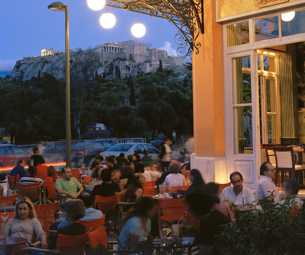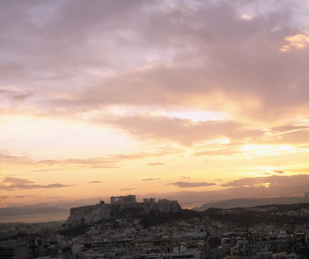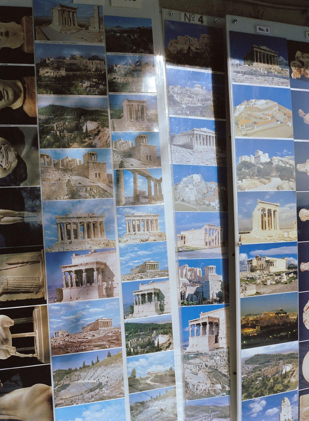Athens used to be a quick stop for most tourists on their way to the islands; they’d see the Acropolis and be on their way. Yet more and more we hear how many of our friends enjoy their time spent in the Greek capital. On our own visit two years ago, we were impressed with the dynamic changes and the vitality of the different neighborhoods. Surprise, surprise—we loved Athens! Zander B. Abranowicz has been traveling to Greece annually since he was a baby with his family. Zander is a recent graduate of Cornell University and spent 3 months doing research in Athens on a Cornell grant. Read his take on Greek’s economic woes on his blog under the title, The Gun is Heavy. Here he outlines a pretty perfect day in Athens, take it from us, we used it!
Tripper Tips:
For the best homemade leather sandals you must visit The Poet Sandal Maker of Athens, a gem of a store located right off Monastiraki Square. Third generation Pantelis Melissinos will measure your foot, you pick the style, and in about ten minutes or so you leave with a new pair of Greek sandals. Or maybe more than one…
Check out Hellas, a stunning collection of photographs of modern Greece by William Abranowicz. (Yes Zander’s dad!)
The New hotel is an arty, high-end boutique hotel if you’re looking for something more cutting edge.
The Acropolis, especially in high season, can be packed with tourists, making a visit during the day unpleasant. Go later in the afternoon as the sun is setting for fewer crowds!
9am: After a walk through the Monastiraki Flea Market (1), eat a traditional Greek breakfast of yogurt and honey, fresh fruit, orange juice, and coffee at one of the countless pleasant cafes lining Adrianou (2), a street with an excellent view of the Temple of Hephaestus and the Ancient Agora. Flip through antique post-cards in one of the dusty stores peddling exotic miscellany before moving on.
10am: Walk around nearby Keramikos (3), the ancient potters’ quarter of the city, and Thission (4), the pedestrian-only walkway created around the time of the 2004 Olympics to connect Athens’ incredible archeological heritage sites. Observe the ornate and elegant old apartments and balconies, toward the Acropolis mount. See if you can spot the “peninsula” of apartments that is surrounded on three sides by ancient ruins. Continue up Apostolou Pavlou (5), the road leading into the Acropolis mount area—an archaeological and historical playground.
11:00am: Take a left following signs to the Parthenon. Get a good view of the Ancient Agora (to your left)(6) and continue on to Athens’ essential architectural, historical, and spiritual landmark, the Parthenon (7). Observe some of the inexplicable tortoises that laze about in the sun along your route. If you get lost, hope that you end up on Pnyx Hill (8), considered the birthplace of democracy. On this flat, pine-rimmed hill with an excellent view of the Acropolis, ancient Athenians discussed the governance of the city-state of Athens.
12:30pm: Walk down from the Acropolis mount to Anafiotika (9), on the northern side of the Acropolis mount. Notice the distinct scent of bougainvillea and jasmine. The buildings in this area are smaller and lower to the ground, the alleyways more narrow and winding. Look around, and arrive by some miracle of space and time to a tiny, Cycladic village like those on Santorini, Paros, or Naxos. You have reached Anafiotika, or “Little Anafi,” a neighborhood within a neighborhood built by workers imported to Athens for the refurbishment of King Otto’s palace during his reign in the late 1800’s. Until 1922, when immigrants of Greek descent flooded into Athens from Asia Minor, driven by conflict between Greece and Turkey, Anafiotika was entirely populated by Cycladic Greeks, who imported their singular architectural style to the bustling city to feel at home while they slaved away for the Bavarian king. To this day, the streets are unnamed, and its imported labyrinthine plan—though perhaps “plan” is misleading as it implies a centralized rhyme or reason—once served the purpose of confounding pirates and invaders who would routinely pillage the vulnerable villages of the Cycladic islands. Today, that plan undoubtedly has the same effect on tourists, who rarely have the pleasure of getting lost in its tranquil passageways.
1:30pm: Walk down to the end of Dionysiou Areopagitou, and enjoy lunch and drinks at Café Dionysiou (10), taking in the magnificent view of the Parthenon and the Theatre of Dionysus.
3:00pm: Walk nearby to the magnificent, airy Acropolis Museum (11), completed in 2007. Find “The Moschophoros (Calf-bearer)” from around 570 B.C., and my personal favorite, “Hunting Dog,” from around 520 B.C.
5:00pm: It is hottest in Athens between 4 and 6, making it a perfect time to take a little siesta at your hotel. On your way back and it’s not too hot, catch the changing of the guard at Syntagma, or Constitution Square, which occurs each hour in front of the Greek Parliament (12). If you’re up for it and simply want a break from the heat, visit the magnificent collection of traditional and modern Greek art at the Benaki Museum (13) on Leof. Vassilis Sofias, where there is also a high-end restaurant and café. If you’re looking for a snack and a drink, head to nearby Kolonaki (14), which has been described as Athens’ Madison Avenue. There you will find tree-lined streets, smartly dressed Greeks sipping espresso and eating artisan pizza, and intelligent stores.
7:00pm: Return to your hotel for a rest, a shower, and some wine. It’ll probably be a late night!
9:00pm: Enjoy a classic taverna dinner somewhere in Plaka (15)—look for wherever the Greeks are eating. While you walk there, feel the breeze as you walk by the Temple of the Winds and the Roman Agora. Order mezedes, some favorites being dolmades (rice-stuffed grape-leaves), melitzanes (fried eggplant), choriatiki (Village salad, or what we would call a Greek salad), and keftedes (fried balls of meet, cheese, or vegetables). Ask for some of the traditional Greek spirit, tsipouro, after dinner but beware—it’s quite strong! After dinner, go for a digestive stroll around Plaka, enjoying quirky cafes like Yiasemi. Look for the old Capuchin monastery where Lord Byron once stayed after paying homage to the Ali Pasha in Ioannina, the formerly Ottoman city in the Northwest of Greece. Find the street painting of a blue man in motion that marks the point where Byron street—Oδός Βύρωνα—becomes Shelley street in a clever reflection of both the relationship of these two literary geniuses as well as a commemoration of their love for the city of Athens. In a small square at the higher reaches of Plaka, get lost looking through a bookseller’s wares, hypnotized by the beautiful old Greek book design, with their coarse bindings, hand-drawn cover art, and perfect typography.
11:00pm: Go to Six Dogs bar (16) in Monasteraki, a bar that you must know of to find, as it is hidden down a garbage-strewn, graffiti-ridden alleyway and through a subterranean staircase that opens up into a multi-tiered, open-air courtyard that is a real oasis from the hustle and bustle of the Athenian metropolis. Surrounded by clever-looking young Greeks, enjoy cold drinks in the warm summer air, and hear Greeks say, “Crisis? What crisis?”
12:30am: Hop over to Taf bar (17) in Monasteraki, accessed by walking through the Athens Flea Market, which will be shuttered but populated with street musicians playing often beautiful traditional Greek music. Taf often features an incredibly smooth jazz band or DJ that gives the somewhat hidden bar an intoxicating, ethereal vibe. View the gallery spaces on all sides of the courtyard, and if you’re lucky, the main gallery space will be open for your viewing pleasure.
2:00am: Walk along Apostolou Pavlou toward the Parthenon (as you did early in the day) to the Areopagus (18), an outcrop of bare rock beneath the Acropolis where St. Paul lectured to the Athenians, and now young Greeks bring guitars and wine to enjoy the unparalleled view of the city. Close attention to the perfumes of flowers and pine mingle with a real sense of communion with history, philosophy and the basic foundations of civilization. All of these forces converge in the individual in Athens by night. Lucky you.
Lodging Choices:
Inexpensive: Acropolis View Hotel
Moderate: Hotel St. George Lycabettus, Athens Hilton, Divani Caravel Hotel
High-End: Hotel Grand Bretagne
- 10.17.14






